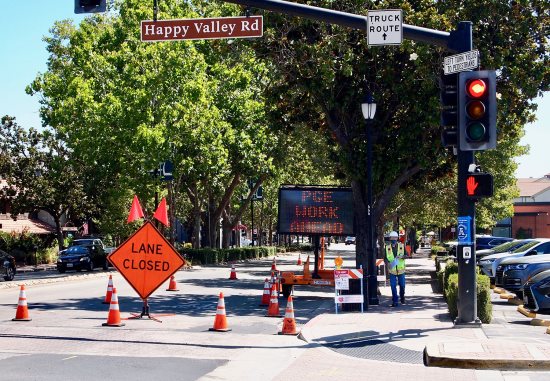
| ||||||
Described as a "safety and reliability" project, hydrostatic pressure testing is designed to test pipeline strength and integrity by filling the pipeline with water and increasing the pressure to a level much higher than normal operating pressure. Pacific Gas and Electric Co. will repair or replace any pipeline that does not meet acceptable standards.
PG&E spokesperson Tamar Sarkissian says they do not anticipate any disruption of service connected with the work, explaining that customers in this area receive gas from two transmissions lines, which are the large high-pressure gas lines that transport natural gas throughout the state. "The transmission lines then provide gas to distribution lines, which are lower pressure, lower diameter lines that serve communities directly," she says.
While the transmission line is undergoing testing, customers will continue to receive natural gas service from the second nearby transmission line, while the other line is temporarily not in service. "Once the test is completed, we expect that natural gas we will be reintroduced to the line," Sarkissian says.
According to Sarkissian, this section of pipeline is due for federally-required assessment before the end of this year and has no correlation to the Lafayette Transmission Integrity Management audits by the California Public Utilities Commission; audits that Lafayette's Gas Safety Task Force has long-called for.
"We're glad for the strength testing," says GSTF Co-Founder Gina Dawson, adding, "It should lead to safer pipelines in the heart of downtown as well as consideration for automated shut-off valves to protect the city center." Dawson says she is disappointed PG&E didn't communicate with the GSTF directly.
Save Lafayette Trees - a group formed in response to PG&E's proposal to remove hundreds of trees in Lafayette under the Community Pipeline Safety Initiative - and the GSTF are focused on PG&E's safety priorities. They say the CPSI is misguided.
"The CPSI calls for destruction of hundreds of trees without context of more significant pipeline safety threats to the public. There are laws for pipeline integrity testing, none for tree removal," says Dawson, adding that pipeline testing is a core part of proactive, preventative safety protections.
Noting that the pipeline sections in downtown Lafayette are almost 70 years old, Dawson says PG&E has no testing records to show for them. "Untested transmission pipeline runs counter to state laws passed after San Bruno's tragic gas incident."
Members of the GSTF are glad the utility is receiving audits from the CPUC, the first of which was completed in June. "Untested, high pressure, vintage pipeline under busy downtown roads has long been a red flag for us," says Dawson. "Prior to the (June) audit, PG&E had no testing schedule for downtown pipelines until 2026. Due to the long list of GSTF safety concerns, the CPUC added a second audit week for December of this year."
The utility informed the city of the work on Aug. 7, just days before work started Aug. 11, but Sarkissian says they had in fact already notified roughly 1,500 customers in the immediate area of construction, and had been working closely with the city on the project for some time for permitting and planning purposes.
Reach the reporter at:
